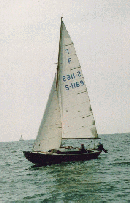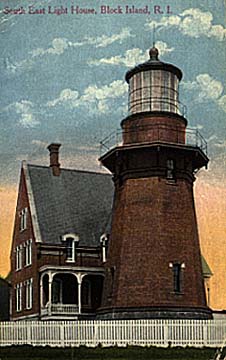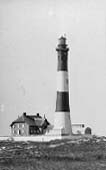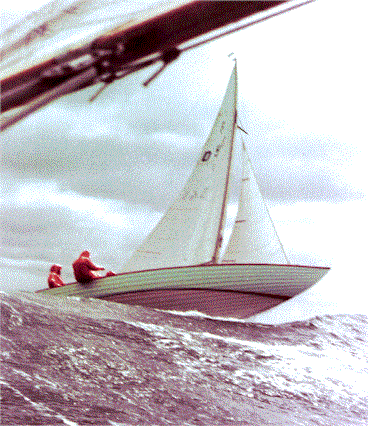
Saga of the Vaga
or
That Which Does Not Kill Us Makes Us Stranger
By Glenn Morton
with editing and comments by Andrew Buck

The Vaga, which means "wanderer" in Swedish, is a 26' wooden Nordic Folkboat built in Sweden in 1947 with a lapstrake hull. Lapstrake hulls are constructed by overlapping the planks like the clapboard siding of a house instead of laying them edge-to-edge. The specifications are: 7' beam, 3'11" draft, 2200 lbs ballast, no standing (barely sitting) headroom and two pilot berths. Additional equipment on the boat includes: Loran, VHF radio, autohelm, 4 sails, 3 compasses, radar reflector, anchor with 300' rode and a Porta-Potti.
Headroom deserves further comment. A three year old might have standing room in one of these boats. There was sitting head room over the porta-potty only because it is set up in the campanionway. If the hatch is open then you can sit up straight. If it is raining then you have a problem. And of course, since the hatch needs to be open in order to sit up straight, use of the porta-potty allows one to carry to the next level LBJ's penchant for conducting business from the throne.
Folkboats have a reputation of being good seaworthy boats and they are small enough to be easily handled by one person. In fact, the first single-handed race across the Atlantic in 1960 was started by the owner of a Folkboat, and two of the five boats participating in the race were Folkboats. Both boats finished, but the fact that 40% of the boats in the race were little more than day-sailers begs the question of the sanity of those who sail off-shore all alone.
The purchase of the Vaga was Robin’s idea. We first saw Folkboats in a coffee table book of wooden boats and we immediately liked them. When one was advertised in Wooden Boat magazine, in May of 1996, I called but we didn’t go see it until October. It was kept in Brewer’s boatyard in Tiverton, Rhode Island on the Sakonnet River. I offered the owner, Ted Davis, $7000 not knowing that he was asking $10,000. He said he had receipts for materials he used in the restoration that totaled $8000 but he would sell for $7500. Deal.
I traveled to Brewer’s boat yard in Tiverton, Rhode Island on five weekends in April and May to get the boat ready under the watchful eye of Ted. He was a font of information and wisdom. A typical observation was 'she leaks but I don’t where from'. OK, no big deal he sailed the Vaga for eight years so how bad could it be. Well bad enough because Ted now had a 35-foot fiberglass boat but we didn’t discuss that. He had all of the bright work on the Vaga gleaming and I thought the boat looked great.

Each weekend I would arrive early Saturday morning with coffee and a newspaper, climb up the ladder into the cockpit and imagine I was out on the water. I would feel the brisk breeze on my face and enjoy the peace and serenity while daydreaming of all the different places the Vaga would take me.
Rob had helped me outfit the boat with all of the essentials and then some. Sleeping bags, tea bags, trash bags, lots of bags. Eggcrate foam mattresses, a cooler, two safety harnesses, lifelines, fire extinguisher, binoculars, flares, first aid kit, cell phone and bottled water. I bought a little tea pot and a gimbaled single burner propane stove. The item I was most excited about was a G.P.S. receiver for $249 from West Marine. This handheld device would allow me to determine my position within 1000 feet based on signals from up to 12 satellites.
{This was a wooden boat a mere 50 years young. My advice to Glenn had been to have her surveyed before he bought the boat. Advice freely given is not always advice heeded. This said, I dearly love to sail and this was an opportunity. I've sailed with Glenn in the BVI and on Chesapeake Bay and we've always had a good time, so what the heck.}
Sunday, June 8, Andy Buck met me at Nelson Marine in Island Heights, New Jersey. This was to be the Vaga’s new home. I knew Andy from our bike racing days and sailed with him on several occasions and considered him to be extremely knowledgeable. This was essential because I knew little or nothing about actually getting a boat from point A to point B on the open ocean. Andy also brought his inflatable liferaft, spotlight, jacklines (to attach our safety harness) and his G.P.S. receiver. Andy also brought his chart pack and navigating paraphenalia and had plotted a course for us. I was very impressed since I was just planning to come out of the river and turn right.
Jay from Nelson Marine accompanied us on the trip up to Rhode Island so he could drive my car back to New Jersey. Ted and his wife were at Brewer’s to see us off. We unpacked the car, loaded up the boat and decided to cruise around the river so Andy could familiarize himself with the boat.
{On arrival in Tiverton we had to make the obligatory trip to West Marine. No trip on on a boat is possible without at least one pre-departure trip to the boat store. Our trip was for necessities, as they say. Just in case we should need it, we bought fittings for the outboard gas tank. We also bought a gimballed propane gas ring for cooking.}
We weren’t supposed to leave until the next morning, June 9, but everything on the Vaga was ready and it was such a nice Sunday evening on the little introductory sail that we decided to leave early. So we went back to the dock to fill up the water containers and we were off.
Andy had estimated that the trip was going to be 180 miles and take a minimum of three days. We had only been sailing down the Sakonnet River for an hour when we had gotten two buoys from lobster pots stuck between the keel of the boat and the rudder. This brought the boat to a standstill until I cut the line leaving the two buoys stuck to the boat. Besides creating a drag and impeding our progress, the buoys banged on either side of the hull. This was a problem since we planned to sail straight through from Rhode Island to New Jersey, so one of us would sleep while the other handled the boat. But the banging would make sleep impossible.
{The trip down the Sakonnet was a very pleasant reach. The kind of evening sailors dream about, until we tangled with the lobster pot warp. Glenn understates the color of his hands and the height of the high tide mark on his shirt sleeves.}
Andy’s idea was that I strip down and put on his snorkel and dive in to the water to cut the buoys free but since my hands had turned blue from the few moments it took to cut the line earlier in the evening I suspected Andy of trying to appropriate the Vaga. Besides it was his turn to sleep and I was hoping that by the time I turned in somehow the buoys would free themselves.
{Well after dark we didn’t seem to be making much progress. The wind had died and we didn’t seem to be able to keep the boat on any one tack. It was almost as though against our will we were going in circles, nearly in place. Peering in the water with a high intensity flashlight Glenn detected a lobster pot float. After many failed efforts to get the thing loose without cutting the warp, we finally had to cut the pot loose, leaving the float still attached to us. We were on our way again.
As the night progressed the wind picked up a little and the night air continued to cool. One set of Glenn’s clothes was wet from the lobster pot episode. With the wind rising we made better progress down the river. But there was a price to pay. As our speed rose, that damn float began to beat on the hull.}
As the night and the banging wore on, the sun went down and so did the temperature. It was so cold we could see our breath. Andy had some really snazzy foul weather gear and I could just tell he was extremely comfortable as compared to how I felt in my $40, on-sale, wear-once, and throw away foul weather gear that seemed to be collecting moisture even though it was not raining. I had to submit to wrapping paper towels around my head to keep my face warm. This came in handy since my nose also happened to dripping from the cold.
Next morning we were in the ocean and there was no wind to speak of. Andy suggested that we haul in the sails and motor for a while. The problem was, the headsail wouldn't come down so I had to be hoisted up the mast in a bosun's chair to dislodge it. It was just a stroke of fortuitous foresight that Andy happened to have brought along his bosun's chair. Two foot swells seem tame at deck level but at forty feet above the waterline the arc of the mast is greatly exaggerated. I had to dislodge the sail with one hand while holding onto the mast with my other hand and both of my legs or I would get severely beaten about the head with the swinging mast.
 We motored until the wind picked
up and then started to enjoy some exciting sailing. We passed Block Island and ran into
some fog. Late in the afternoon we saw the conning tower of a submarine steaming out of
Long Island Sound. You can't believe how sinister they look. The hull is black. All you
can really see is the tower, a ripple out in front where the bow is pushing the water
aside, and a modest wake at the stern. Then there is the speed. It is hard to imagine that
a ship of that size can move so quickly, so soundlessly and with so little wake.
We motored until the wind picked
up and then started to enjoy some exciting sailing. We passed Block Island and ran into
some fog. Late in the afternoon we saw the conning tower of a submarine steaming out of
Long Island Sound. You can't believe how sinister they look. The hull is black. All you
can really see is the tower, a ripple out in front where the bow is pushing the water
aside, and a modest wake at the stern. Then there is the speed. It is hard to imagine that
a ship of that size can move so quickly, so soundlessly and with so little wake.
 In the early evening we got as far as
Montauk, the eastern most point of Long Island. The wind was against an we wouldn't be
able to tack around the Point in daylight. We elected to put in at Lake Montauk for the
night since it is a sheltered cove with good anchorage. We had a nice hot meal and a good
sleep then left early Tuesday morning.
In the early evening we got as far as
Montauk, the eastern most point of Long Island. The wind was against an we wouldn't be
able to tack around the Point in daylight. We elected to put in at Lake Montauk for the
night since it is a sheltered cove with good anchorage. We had a nice hot meal and a good
sleep then left early Tuesday morning.
We sailed all day and through the night heading southwest from Montauk. Tuesday night was clear and bright but bitter cold and this was in June. It was interesting to suffer from sunburn and frostbite in the same day, especially when we kept hearing on the radio that it was in the 90s on the mainland. Wednesday it was another good sailing day and the Vaga seemed to be a speedy boat for her size and sailed well into the wind. We had a couple of cold meals while under way.
Thursday night Andy was trying to get some sleep while I was at the helm (by this time we had relieved ourselves of the pesky buoys). I noticed the red nightlights on the compasses were getting dimmer. When I checked the ready light on electrical panel, I heard a sloshing sound. I got out a flash light and to my horror saw that the floor of the cabin was under water.
Unbeknownst to us, the boat had been leaking for three days causing the bilge pump to work constantly, drawing down the deep cycle battery. As a consequence we had no power and were taking on water with no operable electric bilge pump. We did have the GPS with its own batteries, so knew we were 27 miles off the south shore of Long Island. The dead battery also meant that we had no radio, so we couldn't call the Coast Guard. We had no running lights so no other boats could see us. And we now had to manually pump the bilge for 60 to 100 strokes every 30 minutes for the next 16 hours until we could put in at Fire Island to buy another battery.
The hard sailing into the wind these past several days had revealed to us some of the boat’s shortcomings. The mast rigging was turning to spaghetti. In fact it appeared that the deck stepped mast was sinking into the deck. The deck leaked profusely, causing us to have to erect a tent inside the boat in order to have a dry spot to lay out a sleeping bag. The mainsheet traveler was so inconveniently located that it suggested to Andy that Ted had never actually sailed the Vaga, since it always seemed to be in the way of either the tiller or the helmsman.
 Coming into
the Fire Island Inlet late in the day, we were exhausted, hungry and cold. We were still
wearing our foulies and most of our extra layers of clothes. This was in stark contrast to
the daredevil kamikazes in sleeveless T-shirts on Jetskis who seemed to be enjoying
themselves while we suffered.
Coming into
the Fire Island Inlet late in the day, we were exhausted, hungry and cold. We were still
wearing our foulies and most of our extra layers of clothes. This was in stark contrast to
the daredevil kamikazes in sleeveless T-shirts on Jetskis who seemed to be enjoying
themselves while we suffered.
The only marina we could find was at the Captree Island State Park which is used by the commercial party fishing boats. We ran aground three times trying to get into the marina. The first grounding came as an abrupt surprise and caused Andy, who was standing on the rear deck, to hurtle forward and come crashing down on my back. We spent the night tied up at the gas dock.
The next day we had breakfast in the snack bar then I got a taxi to Babylon, bought $300 worth of stuff, all of which proved to be unnecessary except for the new battery. But hey, no boat trip is complete without spending money at the boat store. Then I took the taxi back to the boat. After buying more ice for the cooler we were on our way.
It was glorious sail along the south shore of Long Island. Without a working radio we weren't willing to venture too far off shore; no further than we could swim. Between Fire Island and New York Harbor we only had to tack three or four times. Almost all the time we were making well over 5 knots. The seas were running about four feet so life was pretty wet. Even with a warm sun and the work of keeping the bilge pumped and the boat on course, we had to wear our foulies in order to keep warm.

Well, things weren't quite as exciting for us as it is for the crew in the Folkboat on the left. I don't think we ever sailed off a wave, but we had a fair number that were washing across the deck. Of course all that water had to be pumped out by hand. Also a lot of it was going down below trying to soak all our gear. By this time we had our tent erected inside the cabin and had our clothes and sleeping bags wrapped in a tarp like a giant sausage.
Coming into the New York Harbor was a disgusting sail through clumps of oil that were probably pumped from the bilges of freighters. We made it into the anchorage at Sandy Hook, New Jersey by 10:00 p.m. after running aground once again. The moral in this one was that we were too skeptical of the GPS. Had we been more trusting we probably wouldn't have run aground. We slept soundly that night and were back on our way buy 7:00 a.m. Friday morning.
 It is worth adding that by this time
Andy had broken the stove off its gimbal while trying to use the porta-potty out on the
heaving seas off Long Island. Our evening repast, Dinty Moore stew, had to be cooked while
one held the stove on the cabin sole and the other stirred.
It is worth adding that by this time
Andy had broken the stove off its gimbal while trying to use the porta-potty out on the
heaving seas off Long Island. Our evening repast, Dinty Moore stew, had to be cooked while
one held the stove on the cabin sole and the other stirred.
The next morning there was very little wind, it was overcast and drizzly so we motored most of the way. We went through the inlet at Manasquan around 2:00 p.m. and things got sunny and warmed up immediately. We started to shed the many layers of clothing we needed to keep warm.
There are five bridges to pass under between Manasquan and Barnegat Bay. You need a radio to call the bridge tender but since the boat leaked from the top as well as the bottom the radio no longer worked so we resorted to signaling the bridge tender with our fog horn which also seemed to suffer from the experience.
Andy insisted that now that the sun was out he would put on sunblock. I said, "if you do it will surely rain".
It seemed like he was just screwing the cap on the sunblock when the Mother of all Squalls blew right in our faces forcing us to put all of our heavy clothes back on and further prolonging our agony.
 Finally at 5:00 p.m. Friday, two days
later than planned we arrived at the marina. I checked in at the office and the marina
owner was surprised to see me and even more surprised to hear that I arrived with the
Vaga. After I gave her an executive summary of the trip she asked if I still planned to
sail to England in this boat and proceeded to pee herself laughing. Back on the boat Andy
suggested we open the bottle of wine I had brought to celebrate the occasion of our
arrival. I was quite embarrassed since to me it seemed like a pyrrhic victory.
Finally at 5:00 p.m. Friday, two days
later than planned we arrived at the marina. I checked in at the office and the marina
owner was surprised to see me and even more surprised to hear that I arrived with the
Vaga. After I gave her an executive summary of the trip she asked if I still planned to
sail to England in this boat and proceeded to pee herself laughing. Back on the boat Andy
suggested we open the bottle of wine I had brought to celebrate the occasion of our
arrival. I was quite embarrassed since to me it seemed like a pyrrhic victory.
As a consequence of this trip I have discovered the essence of life which can be summarized in these two short sentences.
On Wednesday I stared into the face of death. On Sunday, I still had to mow the lawn.
After telling this story several times it’s been pointed out to me that it was not actually the face of "Death" that I was staring into but a 2nd cousin who looks a lot like "Death".
Subsequently I have read several books about maiden voyages and the common theme seems to be that the owner thinks the boat is sinking. It is nice to know that my experience is so normal.
Epilogue: Glenn and I planned to get together to sail VAGA on Barnegat Bay in the fall. Unfortunately, by the time we were both free the mast step on VAGA had finally succumbed to old age. To salvage the day Glenn and I chartered a Pearson for the day. And, yes, again we ran aground. After both of us tried hiking out to heel the boat, running the outboard, and finally Glenn stripping to his u-trou to pull us off, we agreed to a tow. When I sent him the check to reimburse him for my share of the rental and tow, he has a hard time explaining to Robin the extra $45. The worst part was telling the story about parading around Barnegat Bay in his underwear with me ahouting at him to pull harder.